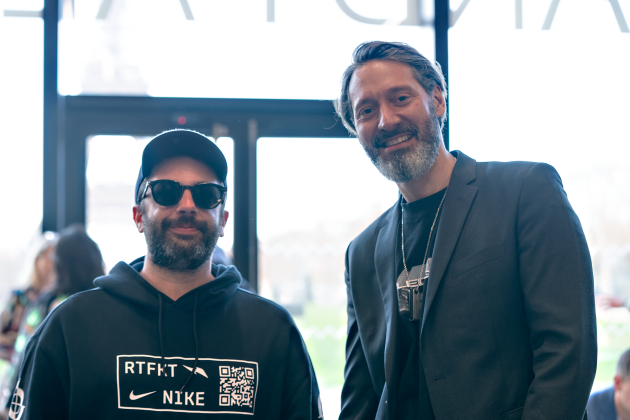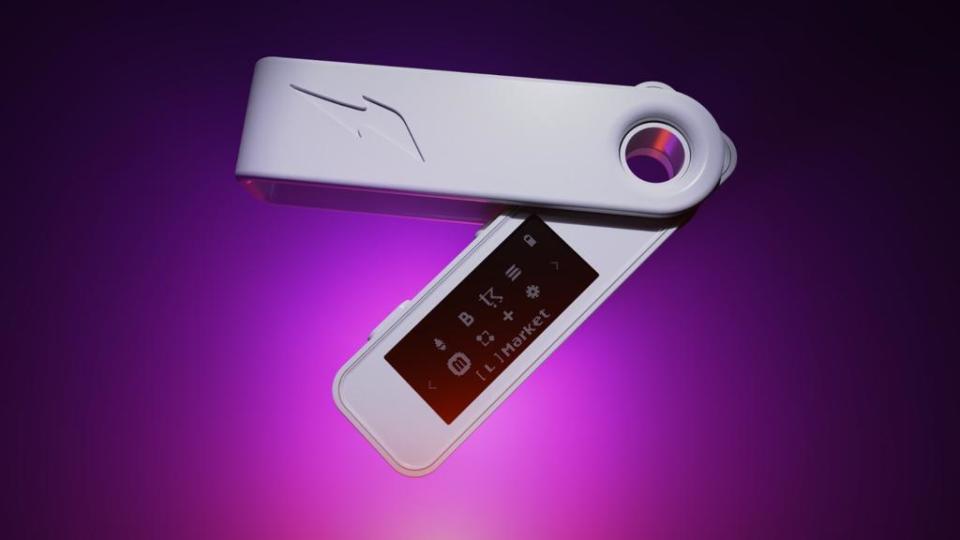Rtfkt, Ledger Dish About Bringing Fashion to Blockchain Security

As Milan stirs with fashion week and Paris catwalks prepare for Monday’s opening, it’s easy to forget that other events exist. But they do, and some offer a different kind of lens on where fashion might go next.
That’s surely not lost on Paris. Because, while next week may belong to the physical collections, on Friday, the blockchain and all things digitally collectible were hot topics, thanks to NFT Paris, a tech and culture conference that has become a magnet for artists, investors, enthusiasts and brands, like Rtfkt and Ledger.
More from WWD
Tiffany and Nike Collaboration: An Exclusive First Look at the Sneakers and Accessories
2020 Holiday Gift Ideas: Google's Top Searched Beauty, Home and Tech Gifts
Rtfkt, a Web 3.0 brand known best as the digital sneaker darling acquired by Nike in 2021, joined the blockchain security company to announce a new partnership, a limited-edition capsule collection of devices and products and a new mission to educate the Rtfkt community and others about safeguarding their blockchain assets.
The education is vital, because as every cybersecurity expert in the world knows, no tech offers 100 percent foolproof protection — not even the blockchain. Rtfkt’s Nikhil Gopalani knows that firsthand. In January, the chief operating officer disclosed that a phishing attack ransacked his wallet and made off with more than $173,000 in NFTs. Phishing is basically an online con aimed at getting victims to give up key info, like logins, using phony links or other tactics, and it’s easy to miss. Such attacks point to a basic truth about cybersecurity: The biggest vulnerability is often human behavior. People can’t stop being people. But they can learn to identify threats and about solutions designed to help. The challenge is making all that compelling, even attractive.
Enter fashion and design. For Ledger, it’s a perfect fit, because fashion really “gets” the space.
“[One brand] was telling us that the link between NFTs and luxury was a very natural one, because both were about creativity, scarcity and community. I think that that resonates with most brands,” Sébastien Badault, vice president of metaverse at Ledger, told WWD. It’s an informed perspective: The company has worked with partners such as Fendi, OPI and Farfetch, and Badault himself hails from places like Google, Amazon and Alibaba.
“They really feel this incredible new way to interact with their community of fans or community of users or potential buyers,” he said. With social media and other platforms, there’s always an intermediary between the brand and consumers, “whereas here, I think what really resonates is this idea of having a direct line into the users and fans. And if they’re going to be doing that, if they’re going to be empowering these communities, they have to make sure that they secure them. And that’s where we play a role.”
Here, the connection between fashion and technology is obvious in the redesign of Ledger’s flagship Nano, a compact unit that looks like a USB thumb drive. The partners recreated the device with simple minimalism in mind, casting two versions — the Nano S Plus and the beefier Nano X — in white metal. Looking at the design, it is literally a clean slate.

But that simplicity belies the complex, technical powerhouse on the inside. Nano can hold private keys, send and receive cryptocurrency and much more, and because it holds the data locally, it’s isolated from remote hacking attempts. That’s just one of several layers of security. Another is that it requires a physical button push to transact, which would foil malicious online actors. It even houses a processor, like a computer, which can calculate the security keys that protect the owner’s bitcoin or other assets.
It’s tempting to think of the wee gadget as a key, since it unlocks virtual goods and experiences, but Ledger describes it as a hardware blockchain wallet, as a place to stash information and IDs (or authentication). In reality, it’s probably both: Imagine holding a key, stuffing it into a wallet packed with other keys, then putting the billfold into a high security vault and activating lasers all around the building, which is surrounded by a moat.
All that security is necessary, because when cryptocurrency, designer NFT wearables or digital couture artworks are stolen, there’s no getting them back. In the future, the stakes could grow, as shopping histories, financial data, medical information, academic records, driver’s licenses and more head to the blockchain.
Ledger argues that this is what its Nanos were built to prevent.
Ian Rogers, Ledger’s chief executive officer, said the blockchain’s ubiquity looks like an inevitability. Take retail, for instance, where “token-gated commerce is on the rise [and] Shopify just announced token-gated capabilities for its platforms,” he pointed out. From there, it looks like a pretty straight trajectory.
“The reality is that all of our digital value will be tokenized in the near future,” added Rogers, and he sees a pivotal role for Ledger in enabling, then securing that. Indeed, that’s the company’s sweet spot. If everything’s bound for the blockchain, everyone will need to keep tokens and keys on them all the time and in myriad ways — like stashed in a pocket, worn on the wrist, hanging from a necklace or tucked into purpose-built clothes. The designs then will matter more than ever.
Now that is fashion’s sweet spot.
The Rtfkt collab is already dipping into that premise with the new Nano and an exclusive case accessory, as a set that’s meant to be worn around the neck together.
According to the announcement, it’s a “super-rare silver pendant with the Rtfkt logo on the end caps, which will come with a Nano X. With allow lists for Clone X and Genesis Pass Holders, this more exclusive drop will be available on [Ledger] Market.” The case design takes cues from a popular NFT vial Rtfkt previously offered. When broke open, these virtual vials unleashed new styles, colors and designs onto the owners’ sneaker NFTs. Now this digital bottle has been manifested as a Nano accessory.
But as an exclusive, it’s not available to everyone. Only owners of Rtfkt’s Clone X and Genesis NFTs can buy the physical vial and Nano set.
“It’s totally made to be a flex,” said Rtfkt cofounder Benoit Pagotto. That’s not idle chatter, coming from an NFT brand that has proven over and over that it knows what excites the community and how to deliver it in a way that peaks demand.

Pagotto landed on fashion’s radar in 2021, when his digital sneaker NFT collab with artist Fewocious stunned the industry by pulling in more than $3 million. Within a year, Rtfkt went from a small two-person operation to a multi-million-dollar business backed by Andreessen Horowitz to a Nike company and a key player in the parent company’s metaverse initiatives.
But, Pagotto makes it clear that Rtfkt is still a brand with an indie spirit, and even under a large sneaker giant, it still enjoys autonomy. Its partnership with Ledger is a good example. This relationship has evolved over time, but still allows room to pursue new ideas, without the micromanagement of a huge corporation or a need to hew to retail conventions.
For instance, anyone can buy other Nanos directly on Ledger’s e-commerce site, but not the Rtfkt x Ledger capsule collection. People buy the associated NFT first through Ledger Market, then redeem it for a physical Nano S Plus or Nano X, and only 10,000 units of each will be on offer. The exclusive Nano case-plus-Nano X set will be even rarer, with availability limited to certain Rftkt NFT holders. That’s just for starters. More products, experiences and opportunities will follow at a later time, the partners promised.
On the surface, the security company and digital sneaker studio appear to live at different ends of the blockchain. But where they overlap is in their priority on fashion, design and commerce. Ledger runs its own marketplace and offers other services and devices, including the touchscreen-enabled Nano Stax, a larger version created by Tony Fadell, the renowned designer behind Apple’s legendary iPod.
Rtfkt’s design cred speaks for itself, but so does its knack for building community. Such skills have never been more valuable to the fashion sector, and smart companies should be watching how such crypto-native brands and others circulate in gaming, metaverse and NFT platforms. There are important lessons there, with elements that could come to define how social works in Web 3.0.
Safeguarding those communities will only become more important as blockchain adoption grows, so Rtfkt and Ledger are making tech, safety and security education an ongoing part of the partnership. Future collaborations, they said, will come with experiences geared toward sharing and distributing knowledge through “Rtfkt Quests.” Ledger established its own “Ledger Quests,” which rewards the NFT learning process by awarding crypto. These and other efforts will offer a range of information, from crypto basics to blockchain security and safety, with the goal of demystifying the tech and even make the learning process fun.
It remains to be seen if they can pull it off. Making blockchain education and security sexy is a tall order. Then again, if two companies that are passionate about community, fashion and tech can’t do it, it’s hard to imagine who could.
Best of WWD

